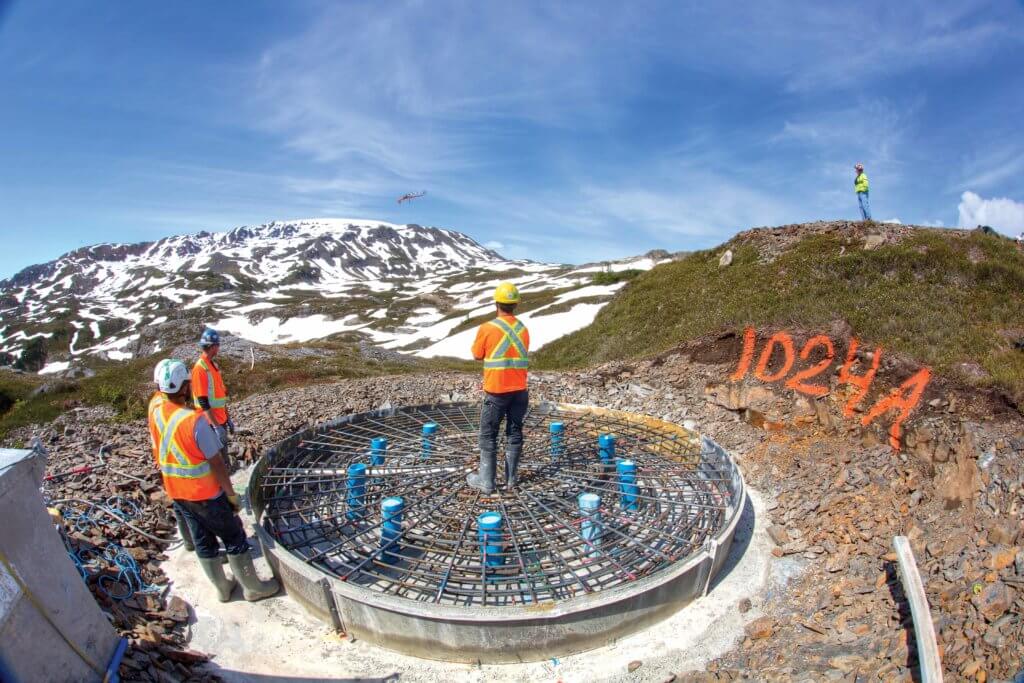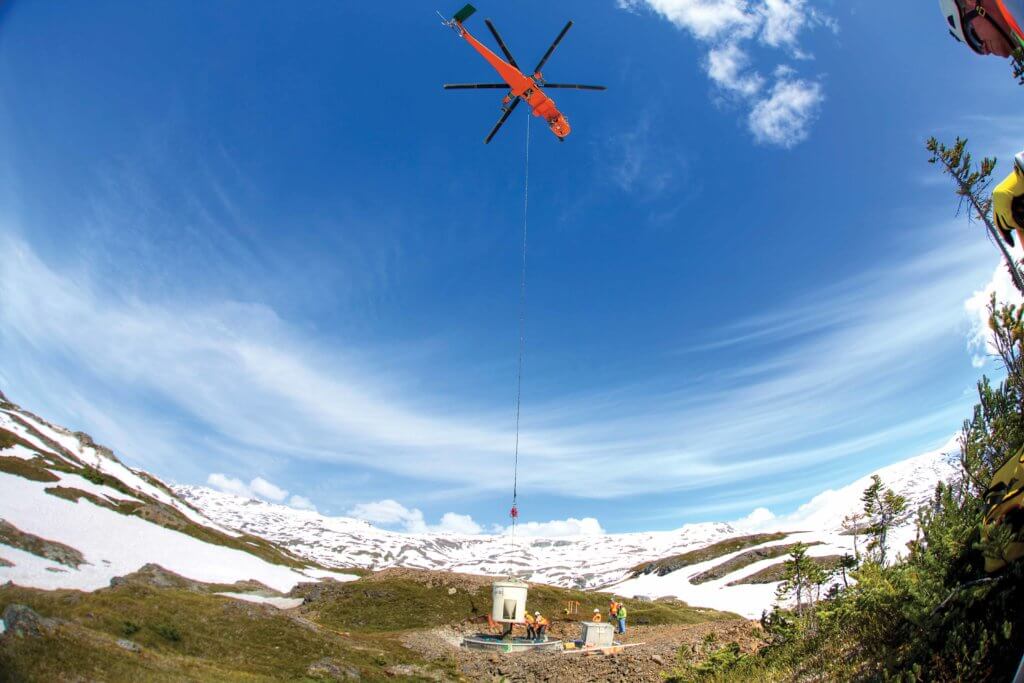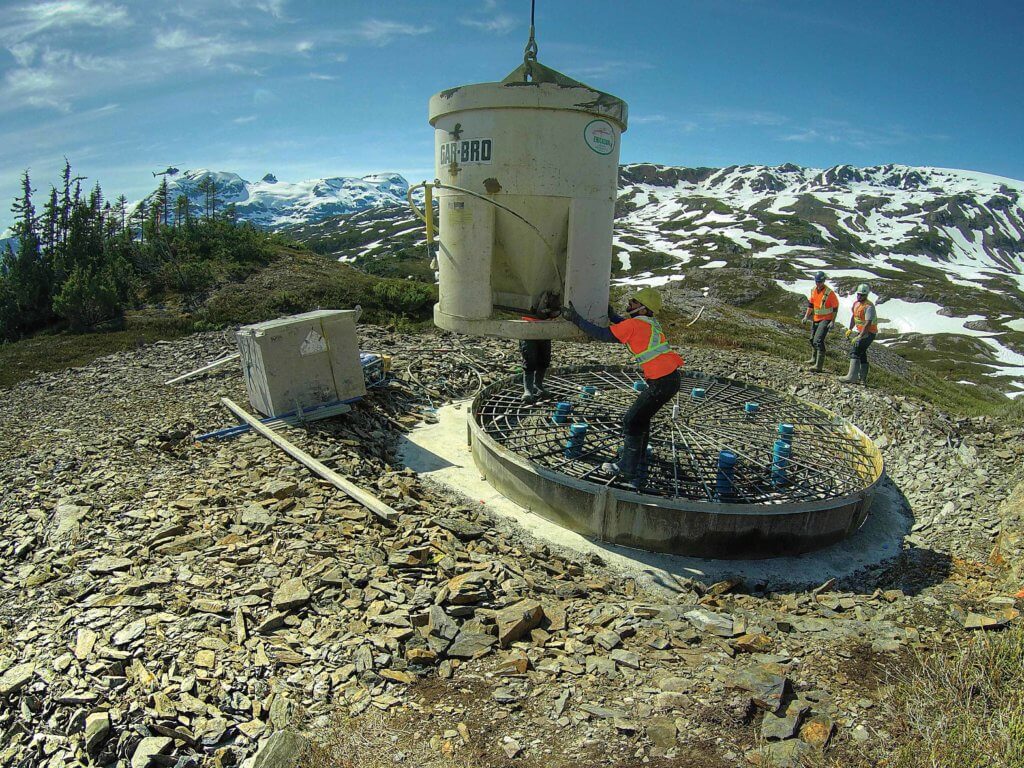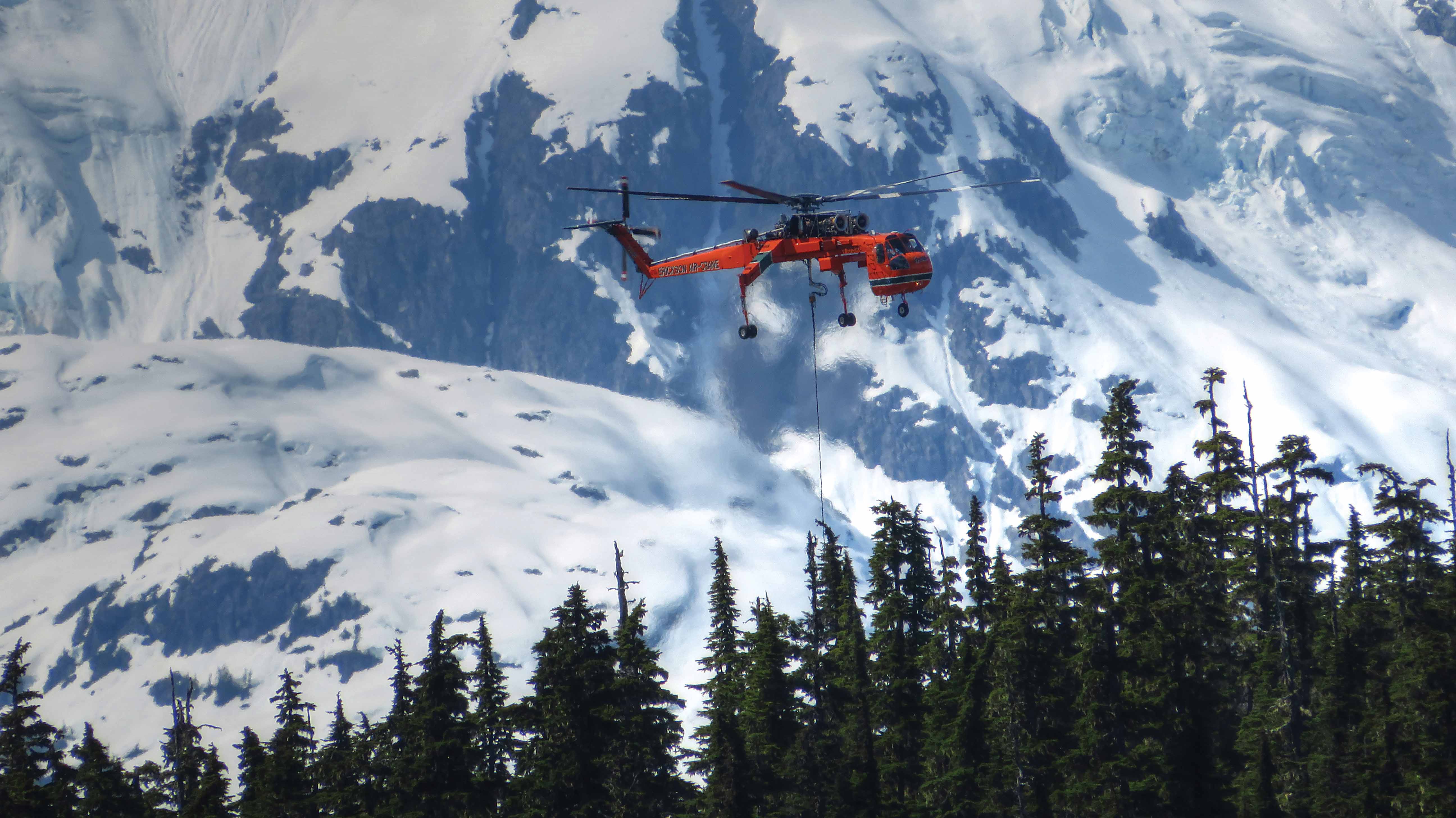In northwestern British Columbia lies the Valley of the Kings. Like its namesake near Luxor in Egypt, the Canadian version contains extraordinary riches. But while the value of the artifacts within the tombs of the pharaohs lies primarily in their historical and cultural worth, the value of the Valley of the Kings in the Pacific Northwest lies in the size and quality of the precious metal it contains: an estimated 6.9 million ounces of gold.

In a period of tremendous strain within the natural resources sector, with exploration and development budgets almost universally slashed, the Brucejack Gold Project to mine the Valley of the Kings is one of the few bright spots for those working in and supporting the mineral exploration industry. Located about 40 miles (65 kilometers) north of the town of Stewart, B.C., and just 25 miles (40 kilometers) from Alaska’s border, the Brucejack Gold Project consists of 122,133 hectares, with proven and probably mineral reserves of 13.6 million tonnes grading at 15.7 grams of gold per tonne — a very high level. Owners Pretium Resources Inc. hope to start commercial production at the US$697-million mine in 2017, and over its anticipated 18-year lifespan, the company believes the mine will produce at least US$2.36 billion of gold.
However, being northwestern B.C., taking the mine from concept to reality is far from straightforward. The logistical challenges of creating such a mine in these remote climes are extreme. The physical geography that isolates the mine — including precipitous mountains, icefields, and enormous glaciers — is compounded by the extreme weather the region experiences, with some of the heaviest snowfall levels in Canada resulting in avalanche hazards on routes to construction camps and the mine itself.
And then there’s the issue of connecting the mine to the grid. Pretium considered several power supply options for the mine, including on-site diesel generation, as well as hydro, wind, and solar power, but the only technically feasible solution was to build a transmission line from the mine to the Long Lake Hydro line near Stewart. And because of the inaccessibility of the route along which the line will be built, it will be entirely reliant on helicopter support for its construction.
Breaking New Ground
Stretching 35 miles (56 kilometers), the 138-kV line will be carried by 132 single steel monopole towers across some of the most rugged terrain in B.C. — including a 1.4-mile (2.2-kilometer) span across a glacier that requires the construction of the highest transmission tower in Canada. Work on the foundations began in April this year and the line is set to be finished in September/October. Because of the severity of the winter weather in this part of the world, that deadline is firm.

So far, the project has already seen the appearance of a Kamov Ka-32A11BC, two Erickson Aircranes (an S-64E and an S-64F), several variants of the Airbus Helicopters AS350 AStar, a Bell 204 and 212, an MD 530FF, an Eagle 407HP, and an Eagle Single. A Bell 214 was set to join the construction fleet shortly after Vertical went to press.
The contractor hired to oversee the creation of the transmission line is Rokstad Power, an experienced power line construction and maintenance company who, for the last two years, has served as the main contractor during the construction of the 155-mile (250-kilometer) Interior to Lower Mainland (ILM) 500 kV transmission line in B.C. The company’s experience on that project made its bid for the Brucejack transmission line particularly strong, said Rokstad construction manager Chad Hepburn.
“Over the last two years, we flew 8,600 flight hours on the ILM project, with no loss or injuries,” he told Vertical. “We did around 13,000 hoists and close to 13,000 touch-and-go’s. We’ve done things that have never really been done.”
That ability to safely break new ground has come in useful when tackling some of the herculean feats required to build the Brucejack transmission line. In the six-month construction window, about 20 million pounds of concrete and 5.3 million pounds of steel will be moved — the latter requiring 391 tower picks for the S-64F Aircrane.
“There’s certain things that have been built into the transmission line making it some of the tightest wire and longest spans in North America,” said Hepburn.
The 1.4-mile span across Knipple Glacier requires the highest altitude placement of towers in Canada — beating a record set on the ILM project by about 100 feet. The 250-foot tall towers will be placed on mountaintops either side of the glacier, with the highest being 6,400 feet. The glacier itself sits about 2,000 feet below.
There will be 17 different styles of tower used across the line, with each assembled in sections designed to be around 19,000 pounds (8,620 kilograms) a pick. For Hepburn, there was only one aircraft he wanted to use to place the towers.
“Our work proposal early on stated that we needed an Aircrane here — an F model — every day,” he said. “Costwise I’ll say it’s a wash to using 214s, a K-Max, 212 Singles, or even S-61s, because then you get into productivity, and we can do an average of four cubic meters of concrete every six minutes [with the S-64F] , and we typically pour 100 cubic meters an hour on some of the closer sites. You know you’re going to get into bad weather working in the northern part of B.C. and Alaska here, so in order to capitalize on the good weather, you’ve got to be as effective as you can during those good weather days, so we gain a lot of schedule progression having the F model here.”
Indeed, poor weather conditions delayed the start of the project to such a degree that a second Aircrane — an S-64E — has been brought in to help compress the construction schedule. (Hepburn believes it’s the first time two Aircranes have been used on the same power line construction project by a contractor.) “We were fighting avalanches just to set the camp up,” he said. “There’s a 45-kilometer-long road and seven different avalanche routes on that road, so we had to send guys out early on with charges to try and initiate the avalanches before we could go through and clear the snow, and the snow on the road was 20 feet deep in some places.”
VIH’s Ka-32s were among the first aircraft on the project in April, and were largely used to move Rokstad’s excavators to help clear the snow. The construction company then contracted Mustang Helicopters for crew moves, primarily using the operator’s AS350 B2s and B3e.
“We’re reliant heavily on B2s and B3s,” said Hepburn. “We operate anywhere from 3,000 to 6,400 feet, so typically with a B2 or B3 they’ve got the performance to be able to do that, and they’ve got a nice interior for moving crews — you can usually move five people at a time.”
The Foundation Crew
Rokstad hired Bear Creek Group — parent company of Lakelse Air — as the civil works contractor, giving Bear Creek the responsibility of constructing the foundations and anchors on the line. Lakelse uses five AS350 B2s and D2s (the latter powered by an upgraded Lycoming LTS101-700 engine) on the project, as well as a Bell 204 and 212.

Where possible, the foundation sites have been located in bedrock. In locations where there isn’t enough bedrock, Bear Creek needs to create micropiles. The first stage of preparation for this requires the site to be drilled or blasted to create a depression in the bedrock, and this is then leveled with fill-crete — a flattening compound that is essentially a low-strength concrete. A rebar cage is then placed on top with a form around it. The Aircrane dumps concrete over the cage and into the form, and then a 16,000-pound donut-shaped steel cap is placed on top of the concrete foundation. Bear Creek’s crews drill holes through the caps all the way into the bedrock, then seal and grout them, creating the rock anchor. The foundation is then ready for a tower.
According to James Carr, director of business development at Bear Creek Aviation Group, Lakelse’s role is to support Bear Creek’s crews by flying them to the tower sites, transporting fuel for the excavators that clear the sites, and on occasion flying the fill-crete to the site.
“The logisitics of it are the most demanding part of it, but the flying is pretty standard for the operations we conduct,” said Carr. “We do a lot of exploration drilling in the area in northwest B.C., and it’s very similar in a lot of aspects. One of the things is the increased aircraft traffic, obviously in the [transmission line] corridor. Some of our guys may not be used to that, but they’re figuring it out.”
Lakelse has a coordinator on site to assist in controlling the flow of traffic around the line. “Any aircraft that go into that workspace, they’ll let our coordinator know that they’re there and he’ll tell them where the [Air]crane is, or where our aircraft are, or what part of the project they’re on,” said Carr.
The main concern Lakelse had going into the project was the weather. “We’ve actually had a very good run of weather recently, but that part of the world can be very rainy and foggy, with low ceilings,” said Carr. “There’s a fair amount of work at altitude, which brings into play weather, and obviously now we’re into summer and when it does get warm, density altitude starts to play a factor as well.”
The standard shift pattern for Lakelse’s crews is two to three weeks on site in one of the camps surrounding the project. Carr said duty days are averaging about 12 hours, with four or five flight hours a day per aircraft.

“It’s nice to be set up on a project for five months so that we can establish the ground ops, and have a 52-foot trailer there that’s all set up with our maintenance spares and a place for guys to hang out,” said Carr. “When you’re not in and out in two weeks or a month, it gives you time to establish a work base.”
Bringing the Muscle
The first Aircrane — the F model — arrived on the project in May, but due to the late snow, an E model was brought in (along with an additional foundation crew) to help speed up the workflow, with the two cranes working from opposite ends of the line towards the middle. The primary difference between the two variants is the lift capacity; the S-64E can lift 20,000 pounds (9,000 kilograms), compared to the S-64F’s 25,000 pounds (11,340 kilograms).
On the Brucejack project, the Aircranes have four basic roles: moving the excavators, flying the concrete, placing the cap on the foundation, and then setting the towers. There are 16 mini excavators on the project that each weigh 13,000 pounds, and another two that weigh 20,000 pounds — and all are moved by the S-64F.
The aircraft have a crew of two to three pilots depending on the type of work they’re completing. If they’re doing long line work from the left seat, only two pilots are required. Precision placement, for tasks such as placing the micropile caps or towers, requires three pilots — two up front and one in the aft seat.
Jeff Stein, powerline sales manager at Erickson Inc., said the tower assembly promised to be the most challenging aspect of the project for the Aircranes. “These are tubular steel structures, and they are very heavy duty,” he said. “Obviously the environment they’re placed in sees a lot of snow, a lot of ice, a lot of freezing and thawing, and a lot of wind, so the towers have to be very, very stout, which makes them heavy. The tubular steel design does require the creation of specific guides to help us align the pieces, and it’s requiring our most experienced aft-seat precision placement pilots to do the tower assembly.”

While Erickson works with many transmission line contractors who provide the ground crews for tower erection, the most difficult jobs require Erickson’s own ground crews to take control. “It’s best for the pilot in the aircraft to be working with somebody on the ground that he’s worked with many times before to ensure the communication is consistent,” said Stein. “Our ground crews understand how to construct towers, but they also understand how the aircraft is operated and all the things the pilots are managing in addition to building the tower.”
Stein said the aircraft’s aft-seat pilot station and its anti-rotation rigging system made it particularly well suited to its role. “Those two features make it the best precision placement machine ever designed and built,” he said. “Together with that tool, it’s really our crews. Without that, we wouldn’t be able to do this level of precision work.”
In terms of support, each aircraft has three mechanics assigned to it, and the crews assigned to the aircraft —mechanics and pilots — are typically on a two-week rotation. “In total, we can easily have upwards of 35 or 40 total crew rotating in and out for both aircraft,” said Stein. “They’ve got long daylight up there and they’re trying to utilize that, so we sometimes have to split the shifts up a little bit, and then we’ll also have one of our project managers to coordinate all the activities and work directly with the customer.”
One of the mechanics working on the project is Bryan Dudas, who has been with Erickson for nine years as a field maintenance technician. He works with another mechanic and a crew chief on the S-64F.
“We take care of the aircraft by doing its preflight inspections, postflight inspections, 30-hour phase inspections, and any maintenance that’s required, such as component changes,” he said. “We also refuel the aircraft, clean it, and move the support equipment around, too.”
The maintenance teams work out of a trailer that contains an enormous variety of parts and components — including spare main and tail rotor blades. “It provides everything we need,” said Dudas. “Our parts inventory has a lot of parts that might need replacing every once in a while, like a pressure switch or transducer, or polyurethane abrasion tape on the main rotor blade.”

Dudas said he has seen a wide variety of wildlife while working on the project, including grizzly bears, black bears, and marmots. “I’ve worked in Greece, Australia, and in these parts before on a similar power line project, but it was more flatlands rather than glaciers and mountains. This is probably the most scenic project I’ve worked on in my career,” he said.
Longstanding Involvement
Yellowhead Helicopters is another operator working on the Brucejack project, but it has been hired directly by Pretium rather than through Rokstad. It has four aircraft contracted on the job: two Eagle 407HPs and two AS350 B2s. The B2s are working primarily on the powerline, flying support for Pretium’s quality assurance, surveying and administration staff, while the 407s are conducting exploration work as well as assisting in avalanche cannon construction.
Yellowhead’s involvement with the project began last fall when the transmission line’s right of way was cleared, during which it used one aircraft to fly the timber fallers. Jim Beise, Yellowhead’s assistant director of operations, said the weather was particularly challenging at that time. “One thing with the falling that’s not like the construction, they’re more flexible with where they can work,” he said. “If we weren’t able to get to a certain area, we’d readjust some equipment and prep in an area where the weather was a little better, at a lower elevation.”
The avalanche cannon construction also began last year. “We used the helicopter to sling in the concrete and equipment for these propane cannons they were putting in,” said Beise. “They’re expanding that this year into another area. It’s quite extensive.”
In addition to the four aircraft contracted to the job, Yellowhead has also been asked to bring its Eagle Single (a single-engine Bell 212 powered by a Honeywell T53-17B engine) to help move communications equipment to enable a repeater link up to the mine (allowing Pretium a cheaper alternative to using expensive satellite phones).
Beise said that, weather aside, communication was the biggest challenge faced by those working on the transmission line. “The radio is really busy, so there are definitely some challenges with communications because there’s so much traffic on the frequencies,” he said. “The guys have to prioritize the air-to-air channel and they use that for traffic separation for the most part. And then there’s a procedure for calling in to the logistics and letting them know where you want to go, what you’re doing and how long you’re going to be.”

The Stringing Specialists
The final piece of the Brucejack transmission line puzzle will be provided by Ascent Helicopters. Utilizing its MD 530FF (a MD 500E with an upgraded Rolls-Royce M250-C30 engine) and its brand-new AS350 B3e, it will string the wire and hang the conductors once the towers are completed.
The MD 530FF is a wire-stringing specialist, and is designed to pull sock line from the side of the aircraft — a much safer way of operating. The B3e will be used to transport crews to and from the job site as well as setting smaller steel or glass pieces. “We have, I believe, quite a few towers above 6,000 feet, so definitely we want the performance of the B3e,” said Trent Lemke, president of Ascent Helicopters. “It’s a great aircraft for that work, absolutely. For precision long line work, everybody loves it. The 530FF, of course, is a [MD] 500 that’s on steroids — it’s quite an amazing performing aircraft.”
Lemke said the type of work Ascent undertakes called for hugely experienced pilots. “A lot of our guys are older experienced guys,” he said. “We have probably five to 10 pilots over the 10,000-hour mark. A lot of these guys have flown the 500 and the 530 way back when the 500s were super popular. So bringing it back online was actually quite an easy decision.”
A strong working relationship with Rokstad was key to making the operation a success, said Lemke. “There have been a lot of high profile accidents in the wire environment and also there’s a multitude of factors that could cause them. We try to eliminate as much as possible by having certain systems in place,” he said. “Probably the first four or five days up there will be just figuring out the stringing program to make sure that everybody is well set up and understanding and trained and the SOPs [standard operating procedures] are in place. So, there’s really nothing that you do that isn’t rehearsed at some point or other or that we haven’t done before.”
Lemke said Ascent was excited to get started on the project. “It’s pretty dramatic scenery, and it’s quite the power line to be built in that geographic area,” he said. “This one is definitely a feather in everybody’s cap, for sure.”

When the power line is connected and switched on, it will mark the beginning of an exciting new phase of development at the Brucejack Gold Project. Thanks to an extraordinarily mixed fleet of aircraft, and some of the most experienced and specialized crews in the industry, the promised riches of the Valley of the Kings will soon be brought within reach.





